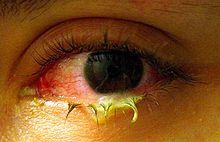Conjunctivitis (Pink Eye) Causes, Symptoms, Pictures, Treatment
The conjunctiva is the a thin transparent mucous membrane that covers the outer part of the eye and continues to line the inner eyelid. It helps with lubrication by producing small quantities of tear-like fluid although most of the lubrication comes from the lacrimal glands (tear glands).
The conjunctiva is similar to normal skin in that it is made up of squamous epithelium although it is non-keratinized. It also serves as a barrier between the delicate eye tissue and the environment and plays an important role in immune responses. The conjunctiva is bombarded daily with dust, chemicals, microbes and other irritants and when injured it becomes inflamed. This causes it to appear red and is commonly referred to as conjunctivitis.
What is conjunctivitis?
Conjunctivitis is the inflammation of the thin clear mucous membrane lining the outer eyeball and inner eyelid. Depending on the cause of the inflammation, conjunctivitis may be categorized as infectious or non-infectious. The most common causes of infectious conjunctivitis are viral or bacterial infections while most non-infectious cases are allergic or due to irritants. If the inflammation also involves the cornea then it is known as keratoconjunctivitis and if it also involves the eyelid then it is referred to as blepharoconjunctivitis. Most people know conjunctivitis by its common name – pink eye or pinkeye.
Causes and Types
Infectious conjunctivitis, mainly caused by bacteria and viruses, are largely acute. Non-infectious and particularly allergic conjunctivitis is more likely to be chronic. A person with depressed immune responses may find recurrent episodes of infectious conjunctivitis which will be considered as chronic conjunctivitis. Mechanical and chemical irritation may also cause conjunctivitis which is usually of a sudden onset and short-lived.
Bacterial
The surface of the eye is not sterile but colonized by certain staphylococci, streptococci and Corynebacterium strains. These bacteria are considered as the normal flora of the eye and its population is controlled by a number of local factors. It also helps to prevent infections by more pathogenic strains of bacteria. However, if the normal flora is disrupted, if there is injury to the conjunctiva or the host’s immune response is affected then the conjunctiva may be prone to a bacterial infection. Contact with others with bacterial conjunctivitis and spread of organisms in acute sinusitis/rhinitis are the most common risk factors even in healthy individuals. Some sexually transmitted bacterial infections like chlamydia, gonorrhea and syphilis may also cause conjunctivitis in newborns after vaginal delivery.
Viral
Viral conjunctivitis is a very common eye infection. Viruses responsible include adenovirus, herpes simplex virus (HSV) and varicella zoster virus. Other viruses may also be responsible but are far less common although frequently arises in immunocompromised patients. HIV may cause conjunctivitis and as immune functioning declines also predisposes to other viral and bacterial infections of the conjunctiva, as with other parts of the body. Viral conjunctivitis is a self-limiting infection and in most cases resolves spontaneously without the need for treatment. It is highly contagious and the more common viruses can spread from one person to another through various modes like shaking hands, sharing contaminated personal items and even through droplet spread by coughing in upper respiratory tract infections.
Allergic
The mucuous lining that compromises the conjunctiva is not dissimilar to the mucous linings of the upper respiratory tract, like the nasal mucosa. Therefore the same allergic responses seen in these other sites, like allergic rhinitis, may afflict the conjunctiva. It is more commonly seen in atopy and is therefore common, particularly in children, for allergic conjunctivitis to accompany allergic rhinitis (hayfever). It can also be seasonal (only in certain seasons) or perennial (throughout the year). It may also involve the cornea – keratoconjunctivitis. Allergic conjunctivitis may less commonly affect any person although it is more likely to occur in a person with a personal or family of history of atopy and co-exists with conditions like allergic rhinitis, atopic dermatitis and less commonly even with allergic asthma. The exact allergens may vary but often includes airborne allergens like pollen, house dust mite and animal hair/fur.
Non-Allergic Non-Infectious
There are various other causative factors and types of conjunctivitis that are neither infectious nor allergic in nature. It is sometimes just referred to as irritant conjunctivitis. This is mainly due to mechanical and chemical irritants like :
- Dust
- Sand
- Smoke
- Fumes
- Vapors
- Air pollution
- Foreign bodies
- UV exposure (electric arcs, welding, sunlamps, snow glare)
Signs and Symptoms
Conjunctivitis may affect one or both eyes. The eye signs and symptoms that may be present to varying degrees include :
- Redness
- Itchiness
- Foreign body sensation
- Discharge that forms crusts. Purulent discharge more commonly seen with bacterial conjunctivitis.
- Excessive tearing
- Temporary blurred vision as a result of discharge and excessive tearing
Picture of Conjunctivitis
 |
Acute conjunctivitis
Picture from Wikimedia Commons |
 |
Pink eye
Picture from Wikimedia Commons |
 |
Bacterial conjunctivitis
Picture from Wikimedia Commons |
Treatment of Conjunctivitis
The treatment of conjunctivitis depends on the underlying cause. The diagnosis can be reached based on the medical history and clinical findings. Sometimes a sample of the discharge may be collected and sent for laboratory testing to identify the causative microorganism. Viral conjunctivitis which often occurs as outbreaks usually does not require any treatment. It tends to last longer than bacterial conjunctivitis but often resolves on its own with time. Bacterial conjunctivitis may require the use of antibiotic eyedrops and ointment. Allergic conjunctivitis may require systemic treatment as well as topical treatment with antihistamines, mast cell stabilizers, corticosteroid and anti-inflammatory drops.



